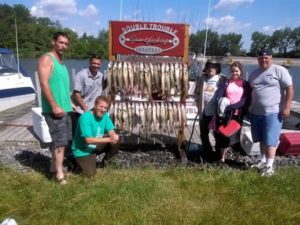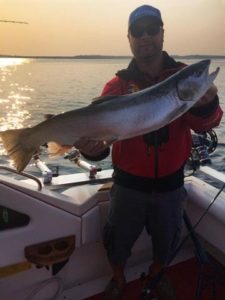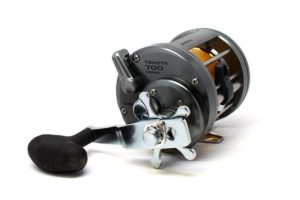If you ask any seasoned angler about their fishing techniques, they always seem to have a single, favorite presentation. Whether it is a professional bass fisherman with that plastic worm, or a seasoned salmon angler with that old Luhr Jensen J-Plug, everyone is guilty of being one dimensional from time to time. This is a problem that has become increasingly apparent on the waters of Lake Erie over the course of the last several years, where small walleye-sized spoons have monopolized angler’s tackle boxes. These spoons surely take more than plenty of fish when the conditions are right, but many anglers seem too content on using spoons in all situations, which can lead to drastically lower catches. At certain times crankbaits and stickbaits can be much more productive, for a variety of reasons. Those savvy enough to incorporate a vast array of methods into their repertoire have a much greater chance of success when they venture out onto the water.
Lake Erie is well known for its abundant walleye population, large schools of yellow perch, and shore-to-shore tourist attractions. But what goes untold is how the fishing conditions on Lake Erie can change in the blink of an eye, or with a simple change of location. Whether it is a change in water clarity, depth, water temperature, or a shift in the spawn cycle; knowing how and when to change methods will significantly boost your success rate. Someone who would know this first hand would be Capt. Mike Kahman. Capt. Mike is not only a seasoned charter captain on Lake Erie, but along with avid angler Jason Vick, he is a proud owner of Matthews Bait & Tackle (734-242-0666) located at one of Michigan’s busiest Walleye ports, Bolles Harbor. Mike has been following the Walleye migratory patterns for over 15 years now and has heard his fair share of anglers talking about how the spoon bite may die from time to time. “These are the times to be versatile” states Capt. Mike. “Crankbaits and crawler harnesses can shine when the spoon bite gets tough. Anglers need to learn to be more open minded during the mayfly hatches and silver bass invasions. Diversity will lead to more consistent catches!”
Early in the year when the fish are either in the spawn or post-spawn patterns, a stickbait trolled through the shallow spawning grounds is usually the best bet. Some of my most productive types of stickbaits are Down Deep Husky Jerks (either DHJ-10 or DHJ-12), Reef Runner Deep Little Rippers, and Storm Deep Thunderstick Jrs. Many other lures of this type will likely also work, but these models are tried and true. If you are going to experiment with different types of stickbaits, be sure that they have a slow action, because the fish are typically not very aggressive during this time of the year. Speed, as always, is crucial during this time of year and is usually best between 1.0 and 2.0 mph, but should be experimented with until the best speed is found. Take the time to find what is most productive for the given day and the lures that you have in the water.
After the spawning cycle is completed, the walleye begin to school up and create their summer feeding patterns. As the water temperature warms into the 60 degree range, the spoon bite will begin to pick up as the walleye start feeding aggressively, but this may not be the best choice during this phase of the walleye migration. The reason for this is because this is usually the exact time that silver bass are beginning their spawning run and feeding heavily. If you are in an area that contains both species it is likely that the bass will attack the spoons long before the walleye ever get a chance to. Due to this it is more practical to run crankbaits such as Storm Wiggle Warts, Hot ‘n’ Tots, Deep Thunderstick Jrs. and the aforementioned Reef Runner Deep Little Rippers because they catch far fewer silver bass and maximize your lures’ time in the water. If you find that you are still having a problem with bass, increasing the speed will usually get rid of this problem. Don’t be afraid to increase it to 3.0 mph or slightly above, especially if the water temperature is in the mid 60’s or higher.
Once the silver bass have moved out and the walleye have transitioned to deeper water during the summer months, both spoons and body baits can usually be used effectively. One reason that many anglers choose spoons is because they can be taken to depths of 25-30 feet quite easily with the aid of a diving device such as Big Jon Mini Discs or Luhr Jensen Jet Divers. But if those deeper fish are not responding to your spoon presentation, don’t be afraid to try some of the crankbaits and stickbaits that were mentioned before. Some minor adjustments will likely need to be made to increase the depth of the lures, such as an increase in the lead lengths (sometimes up to 200’) or the addition of an ounce or two of weight in front of the bait. This can be done very easily using Off Shore Tackle’s Snap Weight System and using either the ‘20 Plus Method’ or the ‘50-50 Method’, both are described in any of the Precision Trolling Books: a must have for any serious Great Lakes troller. If you are on a tight budget, snap weights can be substituted by attaching a bell sinker to your line with a rubber band and experimenting with the weight and lead length until you locate where the active fish are. I have had many days on Lake Erie where lures brought down by snap weights will out-produce those without weight 10-1. A few feet in the water column can make a huge difference in how effective your lures are.
Another instance where spoons are often misused is in stained and murky water conditions, which arise from storms, strong winds, and drainage from nearby rivers. When this happens, spoons usually become drastically less effective, due to the fact that the walleye that inhabit these waters simply cannot find these small ‘quiet’ spoons. During times like this it is best to use bodybaits because they make a lot of vibration and noise while moving through the water. Bright colors such as chartreuse and orange are also necessary because they can be detected much easier by fish in low visibility situations.
Another productive method of trolling that often gets overlooked by Michigan anglers is using bottom-bouncers with crawler harness. Very few lures can compare with a live night crawler. When you are graphing fish in the bottom of the water column and other presentations have failed, it may be time to put the crawlers out and try to entice those lethargic fish that are don’t seem to want to leave their deep water haunts. The key to this method is in the speed, which must be slower than any other technique mentioned earlier. It is best 0.5 and 1.5 miles per hour, any faster will remove your lures from the bottom and cause the blade on the crawler harness to spin much too fast.
No matter what your favorite technique for catching walleye from Lake Erie is, there are surely going to be times when it falters. When that happens you must be willing to adapt. An alteration of method could be the difference between a limit catch and an empty cooler.



